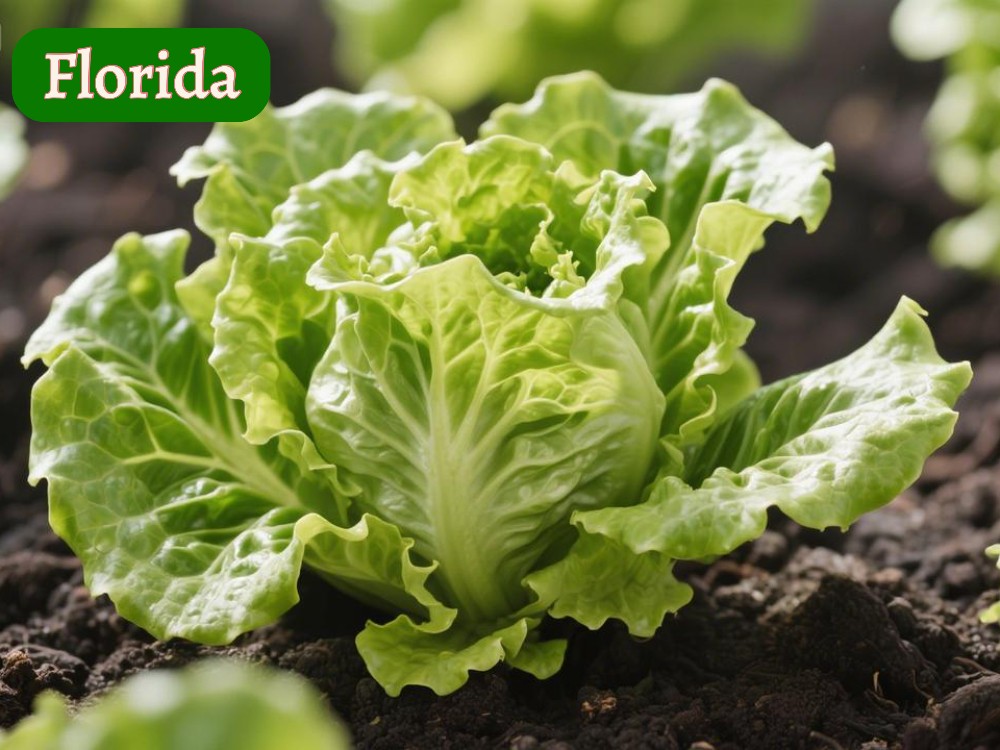Planting lettuce in Florida isn’t just about picking a date from the calendar. The weather here is warm, humid, and always shifting.
That’s why planting timing depends on two big things, the type of lettuce you’re growing and the climate where you live. In Florida, both can change a lot.
That’s especially true in places like Central and North Florida, where seasons are slightly different.
You’re already ahead if you already understand how Florida’s growing seasons work or how lettuce variety and climate shape your planting window.
In this guide, we will discuss how to grow lettuce in Florida the right way, using research-backed info based on your specific area and variety.
Ideal Temperature Range for Lettuce
| Growth Stage | Ideal Temperature | Minimum Tolerance | Maximum Tolerance |
|---|---|---|---|
| Seed Germination | 60–70°F (15–21°C) | 35°F (1.5°C) | 80°F (27°C) |
| Leaf Growth | 55–75°F (13–24°C) | 32°F (0°C) | 85°F (29°C) |
| Head Formation | 60–65°F (15–18°C) | 32°F (0°C) | 80°F (27°C) |
When to Plant Lettuce in Florida? Best Ideal Timing Based on Specific Area and Variety
Before you decide when to plant lettuce in Florida, it’s more useful to understand how it grows.
Lettuce doesn’t like extremes. It prefers cooler days, mild nights, and steady soil moisture.
So the first thing to consider isn’t the general calendar, it’s whether your local weather matches what lettuce needs.
In Florida, climate shifts a lot from region to region. You’re dealing with:
- High humidity, especially in coastal zones
- Long, hot summers that can stress the plants
- Short, mild winters in many areas
These conditions affect both your planting time and the type of lettuce that will grow well.
Florida’s long growing season and Cool Lettuce Crop
Lettuce doesn’t follow the same schedule in Florida as it does in cooler states. That’s because Florida doesn’t offer one consistent growing season. It offers three:
- spring
- fall
- winter
But not every one of those seasons is equally good for a crop like lettuce.
- Spring often warms up too quickly, shortening the ideal window.
- Fall tends to be more forgiving, especially when temperatures begin to drop steadily.
- And in many areas, winter is surprisingly workable for lettuce if you time it right.
A Florida source says: “The highest production time of lettuce in Florida is during January and February”
Florida’s Dormancy Season (Summer) for Lettuce
Now, let’s be clear: Florida summers are intense.
- For a heat-sensitive plant like lettuce, June and July are more than just”challenging”, they are a full-blown risk.
- The high humidity and soaring temperatures create a perfect storm for bolting, leaf burn, and pest attacks.
Lettuce obviously can not thrive in that kind of environment. Some gardeners try to extend the season by using shade cloth or selecting heat-tolerant lettuce types (that have been bred for southern conditions).
These methods don’t change the season, but they can stretch the margins a bit.
Lettuce Planting Time by Florida Region
Florida’s early warmth lets lettuce grow outdoors sooner, but cooler areas need a gentler start. Begin seeds indoors, wait 3 to 4 weeks for true leaves, then transplant once frost risk is gone.
1-North to Central Florida
If you are in North or Central Florida, you get two solid chances to grow lettuce each year. The frost usually arrives around mid-November and lasts until mid-March, so your growing season spans around 238 to 255 days.
First Planting Window (Sep-Nov)
Your first planting should start in mid to late September when the summer heat starts fading. It’s cool enough for lettuce to thrive without too much pest pressure.
Suitable varieties:
- Parris Island Cos (Romaine)
- Buttercrunch (Butterhead)
- Red Sails, Grand Rapids (Leaf)
Second Planting Window (Feb–Mar)
After winter, you get another window starting from late February to early March. Choose varieties that either grow quickly or tolerate early spring warmth. Here’s what works best:
- Salad Bowl
- New Red Fire
- Simpson Elite
East Coastal Florida
In East Coastal Florida (Zones 9b–10a), frost is a brief visitor, just early December to mid-February, giving you over 310 frost-free days.
That means longer growing opportunities. Start planting in late September, and go for a second round in mid-February if the frost threat is gone.
The coastal breeze makes it easier for lettuce to survive, but humidity and disease can still be a problem. That’s why choosing strong, adaptive varieties matters more here.
Fall Planting (Late Sep–Nov):
- Coastal Star (Romaine)
- Adriana (Butterhead)
- Oakleaf, Ruby Red (Leaf)
Late Winter Planting (Feb–Mar):
- Jericho (Heat-tolerant)
- Tropicana
South Florida
Now in South Florida, frost is almost non-existent, so you might think you can grow lettuce all year.
But not so fast, the real challenge here is the intense heat and humidity, especially between April and September.
That makes lettuce bolt or wilt fast. Here, the best-growing window for lettuce is from early October to early April when the weather is milder.
Try to focus on varieties that handle warmth better and don’t bolt quickly. Even here, two good rounds of lettuce can fit into your yearly plan with the right choices.
Main Growing Season (Oct-Apr):
- Jericho (Excellent heat resistance)
- Green Towers (Romaine type)
- Skyphos (Butterhead)
- Sierra, Tropicana (Leaf)
How to Grow Lettuce in Florida?
Alright! Growing lettuce in Florida follows the same basic steps as anywhere else. You prep the soil, sow the seeds, water right, and harvest on time.
If you’re just starting out, here’s a quick step-by-step guide to sow lettuce seeds.
Lettuce is quick to bolt if things get too warm or if your planting’s off by a few weeks. So yeah, understanding its growth stages and lifecycle really matters.
Can YOU Grow Lettuce in the Summer of Florida?
Florida summers are no joke, high heat, sticky humidity, and intense sun. Lettuce really struggles in those conditions. That said, can you grow it in summer? Yes… but only with serious care, and only in some areas.
North Florida
In North Florida, it’s pretty much a no-go. Once May rolls in, it’s too hot, and daylight is too long. Lettuce will bolt fast, and you’ll get bitter leaves before you blink.
Central Florida
The same goes for most of Central Florida unless you’ve got some solid shade setups and grow quick-maturing heat-tolerant varieties.
South Florida
South Florida, surprisingly, gives you a tiny chance, if you’re in a spot with good airflow, and partial shade, and you’re working with raised beds or containers you can move.
But even then, it’s a bet. Bottom line? Florida summers aren’t lettuce-friendly. If you’re dead set on trying, go with varieties like:
- Jericho
- Muir
- Tropicana
- Nevada
And grow them in:
- shaded areas only
- with drip irrigation
- and maybe even under a shade cloth or light netting.
Otherwise, save your effort and wait for fall 🤗.
Can You Grow Cool Lettuce Varieties in Florida?
Yeah! But it totally depends on the ideal planting time. If you’re hoping to grow crispheads like Iceberg or tender Bibb lettuce in Florida, you’ll need to plan around cooler months.
These varieties simply don’t love the heat. Your best bet is to plant them in early fall (around mid-September) or in late winter to early spring (February to March), when temperatures are mild and more forgiving.
In most parts of Florida, especially North and Central zones, these windows offer just enough cool time for these lettuces to thrive before heat stress kicks in.
It’s also smart to look for heat-adapted strains of Iceberg or Bibb if you’re pushing the season a bit. Otherwise, stick to leafier, faster-growing types during warmer months.
Here, the University of Florida describes that all four lettuce types, including, butterhead, crisphead, leaf, and Romain can grow in Florida, but leaf lettuce varieties are more suited for this milder climate.
How to Protect Lettuce From Florida’s Heat
Protecting lettuce from too much warmth is the crucial step in How to grow lettuce in Florida.
When the temperature reaches high, exceeding the targeted lettuce limit, here’s how to protect;
Move Indoors or Keep Under Partial Shade
- It is advisable to plant lettuce seeds in a container or a pots, indoors or outdoors, to stay prepared every time for moving indoors or under partial shade easily without any disturbance.
- Consider growing lettuce in a greenhouse for year-round harvest and protection from Florida’s intense heat, especially during summer!
Use Shade Cloths and Mulch
- Apply 30 to 50% shade cloths and block direct sunlight, protecting lettuce from overheating.
- Use an organic mulch layer to maintain a cool temperature and retain moisture around the lettuce plant.
Water regularly and Use Mist Spray.
- Lettuce needs consistent moisture, especially in Florida’s warm climate. So, mist leaves to keep lettuce chilly.
- Also, water lettuce in the morning and evening to reduce evaporation during intense sunny days.
Pro Tip: Plant lettuce seeds along with tall plants such as tomatoes and sunflowers to provide natural shade and protect from Florida’s sunny days.






